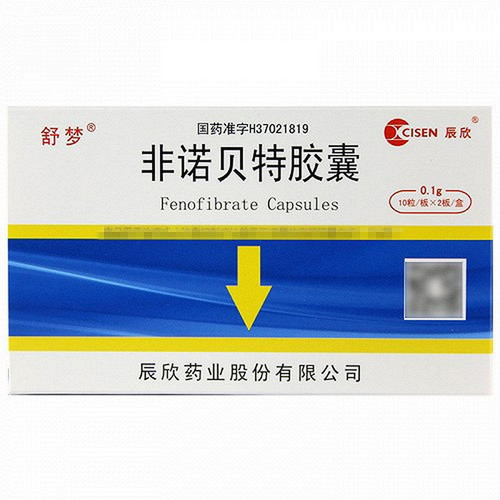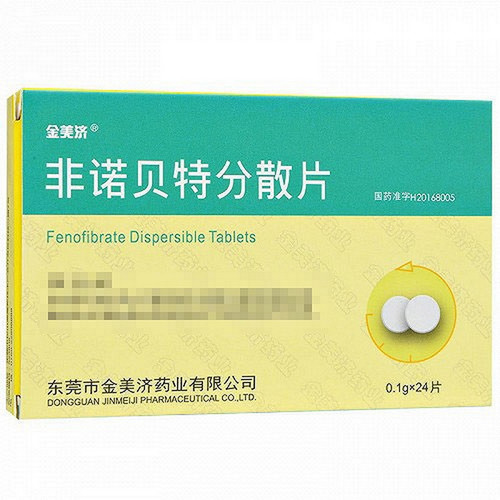Product Overview
[Drug Name]
Generic Name: Fenofibrate Capsules
Trade Name: Liquor Fenofibrate Capsules 0.1g*24 capsules
[Main Ingredients]
The main ingredient of this product is fenofibrate, chemically known as 2-methyl-2-[4-(4-fluorobenzoyl)phenoxy]propionic acid isopropyl ester. Molecular formula: C₂O₄CIO₄, molecular weight: 360.84. This product is a capsule formulation, and its excipient is starch.
[Properties]
This product consists of a white or off-white powder, granules, or pellets.
[Indications/Main Functions]
For the treatment of hypercholesterolemia (type Ia), endogenous hypertriglyceridemia, simple (type V), and mixed (types Ib and H) in adults who have not responded to dietary control. This is especially true when blood cholesterol remains elevated despite dietary control or when there are other concurrent risk factors. Dietary control should be continued during medication. Currently, there are no long-term controlled clinical studies demonstrating the effectiveness of fenofibrate for the primary and secondary prevention of atherosclerotic complications. Fenofibrate has not been shown to reduce the incidence of coronary heart disease and mortality in patients with type 2 diabetes.
[Specifications]
0.1g*24 tablets
[Dosage and Administration]
This medication can be taken long-term in conjunction with dietary control, and its efficacy should be monitored regularly. - Take one tablet daily with a meal. - When cholesterol levels are normal, a reduced dose is recommended. - Patients with impaired renal function: Patients with mild to moderate renal impairment are recommended to start with a lower initial dose and then adjust the dose based on the effects on renal function and blood lipids.
[Adverse Reactions]
See the package insert for details.
[Contraindications]
This drug is contraindicated in the following situations: 1. Patients allergic to fenofibrate or fenofibric acid; 2. Patients known to experience phototoxicity or photosensitivity during treatment with fenofibrate or structurally similar drugs, particularly ketoprofen; 3. Concomitant use with other fibrates (see Drug Interactions for details); 4. Patients with active liver disease, including primary biliary cirrhosis, and patients with unexplained persistent liver dysfunction; 5. Patients with known gallbladder disease; 6. Patients with severe renal impairment, including those receiving dialysis; 7. Breastfeeding women. 8. Due to the presence of lactose in the formulation, this drug is contraindicated in patients with congenital galactosemia, glucose or galactose malabsorption syndrome, or lactase deficiency.
[Precautions]
Warning: Skeletal muscle: Myotoxicity, including rare cases of rhabdomyolysis with or without renal failure, has been reported with fibrates and other lipid-lowering drugs. The incidence of this toxicity is increased in patients with hypoproteinemia and preexisting renal insufficiency. Patients with predisposing factors for myopathy and/or rhabdomyolysis (including age over 70 years, personal or family history of hereditary myopathy, impaired renal function, diabetes, hypothyroidism, and high alcohol consumption) may be at increased risk for rhabdomyolysis. Myotoxicity should be suspected in patients who experience diffuse muscle pain, myositis, painful muscle cramps, muscle weakness, with or without a significant increase in myogenic CPK (greater than 5 times normal), and fenofibrate should be discontinued in such cases. Patients taking fenofibrate should report these symptoms to their physician immediately. Observational studies have shown an increased risk of rhabdomyolysis when fibrates, particularly gemfibrozil, are used concomitantly with HMG-CoA reductase inhibitors (statins). Concomitant use of fibrates and statins should be avoided unless the benefits of lipid-lowering therapy outweigh the risks. Precautions for Use: 1. If lipids do not improve effectively after several months (3-6 months), consider supplemental therapy or other treatment options. 2. Liver Function: As with other lipid-lowering drugs, some patients may experience elevations in transaminases (AST or ALT) after fenofibrate use. These elevations are usually transient, mild, or asymptomatic. There have been reports of hepatocellular, chronic active, and cholestatic hepatitis occurring with fenofibrate treatment over a period ranging from weeks to years. Extremely rarely, cirrhosis associated with chronic active hepatitis has been reported. Recommendations: ① Check transaminase levels every three months during the first 12 months of treatment. ② Pay particular attention to patients with elevated transaminases; if AST or ALT levels rise to more than three times the normal value, treatment should be discontinued.
③ If symptoms suggestive of hepatitis (e.g., jaundice, pruritus) develop and laboratory tests confirm the diagnosis of hepatitis, fenofibrate treatment should be discontinued. 3. Renal Function: There have been reports of elevated serum creatinine levels following fenofibrate treatment, which tend to return to baseline levels after discontinuation. The clinical significance of elevated creatinine is unclear. Regular monitoring of renal function is recommended for patients with pre-existing renal impairment, the elderly, and those with diabetes. 4. Pancreatitis: Cases of pancreatitis have been reported in patients receiving fenofibrate. This may be due to a lack of efficacy in patients with severe hypertriglyceridemia, a direct effect of the drug, or secondary to gallstone formation or bile duct obstruction by cholestasis. 5. Cholelithiasis: Fenofibrate may increase cholesterol secretion into the bile, potentially leading to cholelithiasis. If cholelithiasis is suspected, a gallbladder examination should be performed. If cholelithiasis is confirmed, fenofibrate should be discontinued. 6. Concomitant use of fenofibrate with coumarin oral anticoagulants may enhance the anticoagulant effect of the latter. To avoid bleeding complications, the PT and INR should be closely monitored, and the oral anticoagulant dose may need to be adjusted (see Drug Interactions). 7. Before considering fenofibrate treatment, secondary causes of hyperlipidemia, such as uncontrolled type 2 diabetes, hypothyroidism, nephrotic syndrome, dysproteinemia, obstructive liver disease, medications, and alcohol abuse, should be adequately treated. For patients with hyperlipidemia taking estrogen or estrogen-containing contraceptives, it should be determined whether the hyperlipidemia is primary or secondary (the elevated lipid levels may be caused by oral estrogen). 8. Hematologic Changes: Mild to moderate decreases in hemoglobin, hematocrit, and white blood cell counts have been observed in patients treated with fenofibrate; however, these decreases generally remain stable during long-term treatment. Thrombocytopenia and granulocytopenia have been reported in patients previously treated with fenofibrate. Regular monitoring of red blood cell and white blood cell counts is recommended during the first 12 months of fenofibrate treatment. 9. Hypersensitivity Reactions: Cases of Stevens-Johnson syndrome and toxic epidermal necrolysis requiring hospitalization with corticosteroids have been reported in patients previously treated with fenofibrate. The incidence of urticaria was reported in 1.1% of patients treated with fenofibrate and 0% of patients treated with placebo; the incidence of flushing was reported in 1.4% of patients treated with fenofibrate and 0.8% of patients treated with placebo. 10. Deep Vein Thrombosis: FIELD was a randomized, placebo-controlled study conducted in 9795 patients with type 2 diabetes. In the study, 4900 patients were enrolled in the placebo group and 4895 in the fenofibrate group. The incidence of pulmonary embolism was higher in the fenofibrate group (1.1%) than in the placebo group (0.7%) (p=0.022). The incidence of deep vein thrombosis was 1.4% in the fenofibrate group and 1.0% in the placebo group, respectively (p=0.074).









